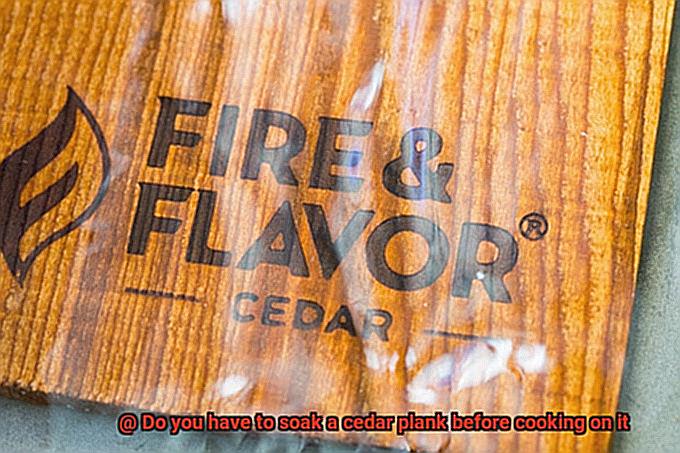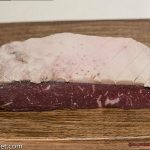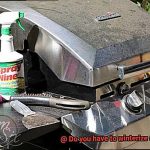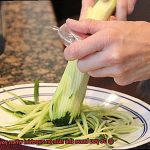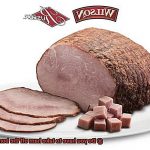Summer is in full swing, which means it’s time to fire up the grill and get cooking. And if you’re looking for a way to take your grilling game to the next level, consider using cedar planks. This popular technique infuses your food with a delicious smoky flavor while keeping it juicy and tender.
But here’s the question: do you need to soak the cedar plank before cooking on it? It’s a topic that sparks debate among grill masters everywhere. Some swear by soaking their planks, claiming it prevents them from burning during cooking. Others argue that soaking actually dilutes the smoky flavor you’re after.
So what’s the truth? In this blog post, we’ll dive into the science behind soaking cedar planks and explore its impact on both flavor and safety. We’ll also take a look at other factors that can affect your grilling results. By the end of this post, you’ll have all the information you need to decide whether or not to soak your cedar plank for your next outdoor cookout. So let’s get started.
Contents
What is a Cedar Plank?
Cedar planks have been used for centuries, and they remain a popular tool for adding flavor to food.
Cedar planks are usually made from Western red cedar, a tree that grows in the Pacific Northwest region of the United States and Canada. They come in different sizes and shapes, ranging from small squares to large rectangles. It is important to choose a plank that will accommodate the food you plan to cook, but not too large that it won’t fit on your grill or smoker.
One of the primary benefits of cooking with a cedar plank is that it adds a unique smoky flavor to the food. When heated on the grill or smoker, the plank releases aromatic oils that infuse the food with a delicious woodsy flavor. Cedar planks are particularly well-suited for foods such as salmon, chicken, steak, and vegetables.
Cedar planks have been used for cooking for centuries, particularly by indigenous people in the Pacific Northwest. They believed that cooking on cedar planks added a unique flavor and aroma to their food while providing a natural way to cook without using any oils or fats. Today, cedar planks are still popular among home cooks and professional chefs alike.
However, one of the most debated topics surrounding cedar planks is whether or not you need to soak them before using them for cooking. Some people swear by soaking the plank for a few hours, while others claim that it’s not necessary at all.
Soaking a cedar plank can help prevent it from catching on fire because cedar planks are known for being highly flammable. Soaking allows the plank to absorb water, helping it resist catching on fire. Additionally, soaking can help infuse more flavor into the food because when the wet plank is placed on the grill, it creates steam that helps infuse the food with the smoky, woodsy flavor of the cedar.
However, some experts argue that soaking a cedar plank isn’t necessary. They claim that as long as you keep an eye on the grill and don’t let the plank catch on fire, there’s no need to soak it first. Additionally, soaking the plank can cause it to warp or crack, which could affect its performance on the grill.
Benefits of Soaking a Cedar Plank
Not only does it add a unique smoky flavor to your food, but it also has several benefits that you don’t want to miss out on.
First and foremost, soaking the cedar plank for at least an hour before grilling is crucial for preventing it from catching fire on the grill. There’s nothing worse than watching your perfectly cooked meal go up in flames due to a poorly prepared plank. Soaking the wood creates steam that helps regulate the temperature and prevents it from burning, allowing you to focus on cooking your food to perfection.
But what about flavor? Soaking a cedar plank also adds moisture to your food as it cooks, releasing steam that infuses into the meat and keeps it moist and juicy. This is particularly beneficial for lean meats like chicken and fish that tend to dry out quickly when grilled. Plus, as the water activates the natural oils in the wood, it releases a sweet, smoky aroma that infuses into the food and gives it an unbeatable flavor.
And let’s not forget about clean-up. Soaking your cedar plank makes it much easier to clean after use. The water helps prevent any food or debris from sticking to the wood, making it easy to wipe down and reuse for future grilling sessions.
To summarize, here are the benefits of soaking a cedar plank:
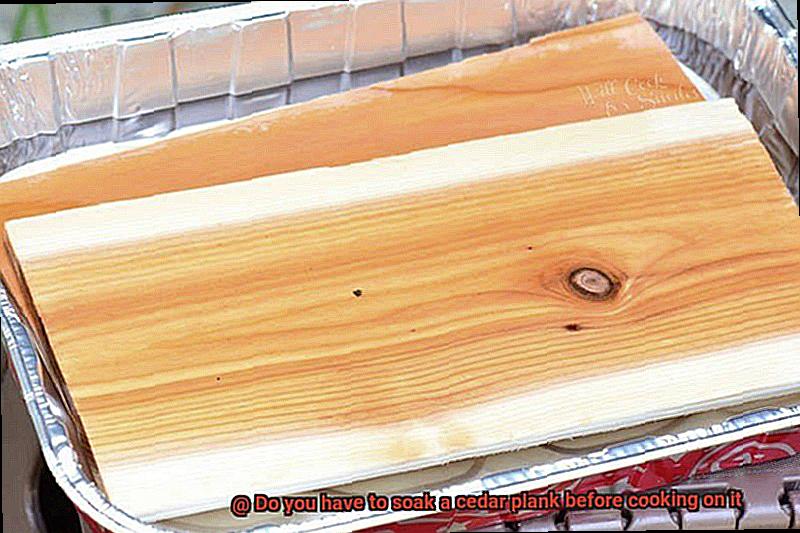
- Prevents the plank from catching fire on the grill
- Adds moisture to your food and keeps it juicy
- Infuses a sweet, smoky aroma into your food for unbeatable flavor
- Makes cleaning up a breeze
Disadvantages of Soaking a Cedar Plank
Before you toss your cedar plank in a bucket of water, it’s important to consider the potential downsides.
One major disadvantage of soaking is that it can cause the plank to lose some of its natural oils, which can negatively impact the flavor of your food. Nobody wants to end up with a bland, tasteless dish after spending time and effort grilling. Additionally, over-soaking can lead to a waterlogged plank that breaks apart during cooking – not exactly the outcome you’re hoping for.
Another drawback to soaking is that it takes longer for the plank to heat up and start smoking. This means longer cooking times and can potentially affect the overall flavor of your dish. The water on the surface can also create steam, causing temperature fluctuations and making it harder to control the heat.
Furthermore, soaking a cedar plank is not a quick process, as it requires at least an hour of soaking time before use. For those who want an easy and hassle-free grilling experience, this may not be ideal. And some people may find that soaking their plank results in a weaker smoky flavor compared to cooking on a dry plank.
What Happens If You Don’t Soak the Plank?
As a seasoned plank-grilling pro, let me tell you that skipping the soaking step can spell disaster for your meal. While it may be tempting to rush through the pre-grilling process, taking the time to soak your cedar plank can make all the difference.
First and foremost, not soaking the plank can lead to a serious safety hazard. Cedar planks are known for imparting a smoky flavor to food, but without proper moisture, they can easily catch fire and turn your relaxing grilling experience into a dangerous situation. Nobody wants that.
But even if you manage to avoid a fire, not soaking the plank can still cause issues. The lack of moisture can cause the wood to crack and split during cooking, leading to uneven cooking and potentially causing your food to fall apart or stick to the cracks in the wood.
On the other hand, soaking the plank allows it to retain moisture and cook your food evenly. This slow and steady cooking process results in tender and juicy meat with a delicious smoky flavor that will have your taste buds begging for more.
So, why risk ruining your meal? Soak that plank for at least an hour before grilling. Here are some reasons why:
- Soaking helps prevent fire hazards
- It prevents cracking and splitting of the wood
- It helps keep your food moist and flavorful
How to Soak the Cedar Plank
Before you start, it’s important to know how to properly soak your cedar plank. Soaking not only prevents the plank from catching fire but also adds moisture and flavor to your dish.
To begin, fill a large container or sink with water and submerge the cedar plank for at least one hour before cooking. For maximum absorption, some experts recommend soaking it overnight. Make sure the plank is fully covered with water to ensure even soaking.
For an extra burst of flavor, consider using other liquids to soak your cedar plank. Beer, wine, or apple juice can infuse additional flavors into the wood that will transfer to your food and tantalize your taste buds.
Once you’ve finished soaking, remove the cedar plank from the water and gently pat it dry with a paper towel. Then, place it on the grill and preheat it for a few minutes before adding your seafood. As the plank heats up, it will steam and smoke, imparting a rich and smoky flavor to your dish.
Tips for Grilling on a Cedar Plank
Grilling on a cedar plank is a unique and flavorful way to cook your favorite foods. However, before you can begin grilling, it’s crucial to prepare the cedar plank properly by soaking it. In this article, we’ll explore the importance of soaking a cedar plank before grilling on it and why you should follow this step.
Prevents the Plank From Catching Fire
The primary reason for soaking a cedar plank is to prevent it from catching fire on the grill. Cedar planks are highly flammable and can ignite easily if not soaked in water before grilling. By submerging the plank in water for at least an hour, it absorbs moisture, which helps resist catching fire.
Infuses More Flavor into the Food
Soaking the cedar plank also infuses more flavor into your food. When the wet plank is placed on the grill, it creates steam that helps to impart a smoky, woodsy flavor of the cedar onto your food. Soaking the plank longer will result in a stronger flavor infusion.
How to Soak the Cedar Plank
To soak a cedar plank properly, submerge it in water for at least an hour before grilling. Some experts recommend soaking the plank overnight for maximum flavor infusion. You can also add wine or beer to the water to add more depth to the flavor. After soaking, remove the plank from the water and pat it dry with a towel.
Preheat Your Grill
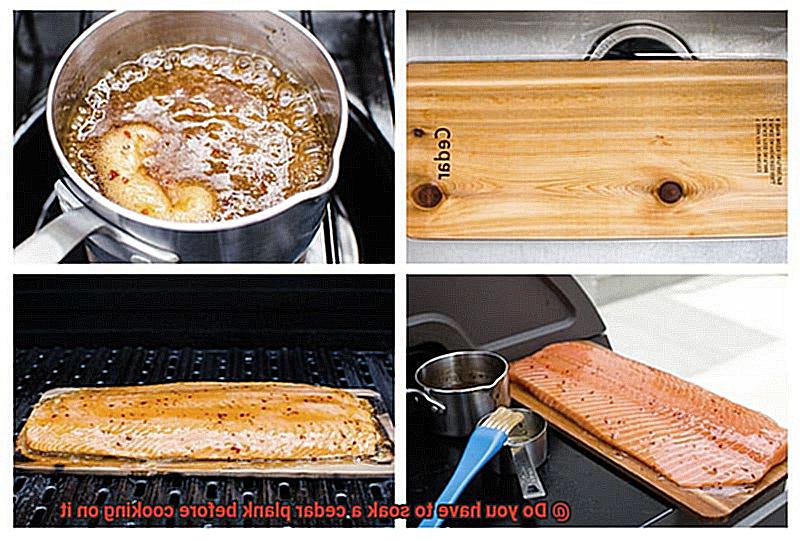
Before placing the soaked cedar plank on your grill, it’s essential to preheat it first. Preheating your grill ensures that your cedar plank is hot and ready when you add your food, leading to even cooking and better flavor.
Ideal Foods for Grilling on Cedar Planks
Cedar planks are perfect for seafood like salmon or shrimp and vegetables like asparagus or zucchini. However, you can also experiment with other meats and fruits like chicken or pineapple to add unique flavors to your dishes.
Best Foods to Grill on a Cedar Plank
The smoky flavor and juicy texture that the cedar wood imparts on your food will elevate any dish to the next level. But, if you’re wondering which foods work best with this method, fear not – as an expert in all things grill-related, I have compiled a list of the best foods to grill on a cedar plank.
Seafood lovers, rejoice. Cedar planked salmon is a classic dish that is both easy to make and always a crowd-pleaser. The natural sweetness of the fish is enhanced by the cedar wood, and it remains succulent throughout cooking. And if you’re feeling adventurous, try grilling shrimp on a cedar plank – the smoky flavor is unmatched, and the wood helps prevent them from drying out.
For those who prefer poultry, cedar planked chicken is a favorite among grill enthusiasts. The wood imparts a subtle smokiness to the meat, keeping it juicy and flavorful. Consider marinating the chicken beforehand for an extra burst of flavor.
Vegetarians can also enjoy the benefits of grilling on a cedar plank with mushrooms as their protein source. The earthy flavor of mushrooms pairs well with the smokiness of the cedar wood. Finally, don’t forget about delicious side dishes like cedar planked asparagus – it complements any grilled meat or fish and adds an extra layer of flavor to this already tasty veggie.
2Z__aJ9wFVg” >
Conclusion
In conclusion, cedar planks are a game-changer for anyone who wants to elevate their grilling game. The question of whether or not to soak the plank before cooking on it may be up for debate, but there’s no denying that soaking has several benefits that are worth considering.
Soaking can prevent the plank from catching fire, infuse more flavor into your food, and make clean-up easier. However, it’s important to note that there are also some potential downsides to soaking, such as losing natural oils and longer cooking times.
If you decide to soak your cedar plank, don’t just dip it in water and call it a day. Properly submerge the plank for at least an hour before grilling and consider adding wine or beer to the water for extra flavor.
And when it comes time to grill, remember that preheating your grill and choosing the right foods – like salmon, chicken, shrimp, mushrooms, and asparagus – will help ensure success.

